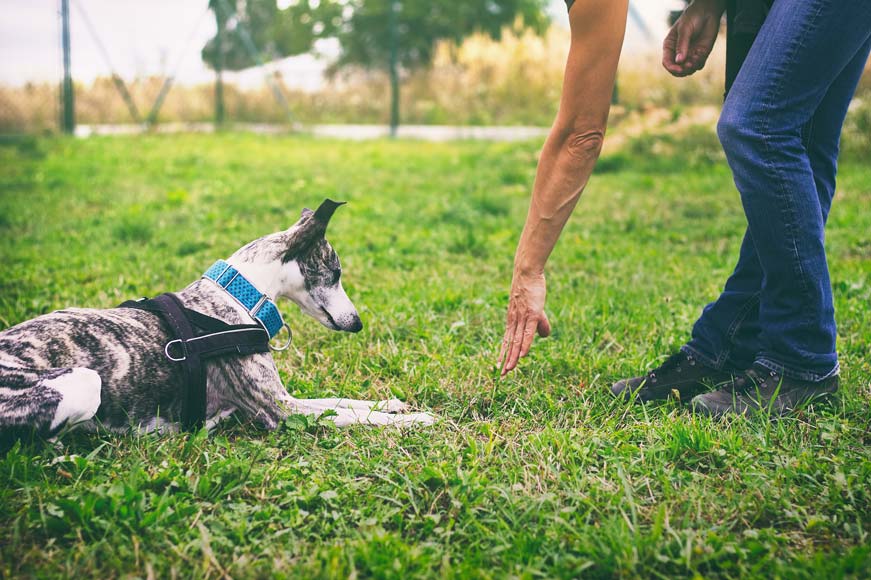3 Commands That Could Save Your Dog's Life

Dog training is a fun activity for both humans and dogs. It helps our canine friends stay mentally sharp, uses up energy that might otherwise be spent engaging in unwanted behaviors, and strengthens the bond between a dog and owner.
Additionally, training your dog well has real, tangible benefits for quality of life for both of you. And teaching your dog to respond immediately to the following three commands may actually save your dog's life.
Come
The come command is a crucial one to teach your dog. Not only is it useful for when you need to do something for him, but it can also mean the difference between life and death in some situations. For instance, if you are outside and she gets off her leash, your dog must come when you call her or she could get hit by a car or become lost.
For more specifics on teaching your dog this command, check here: "Teaching Your Dog to Come."
Sit/Stay or Down/Stay
The sit command is another highly useful one to make sure your dog understands and responds to. You'll probably use this one daily for a whole host of reasons, but it's especially important that your dog knows how to sit in situations where not doing so might cause a problem. For instance, if you're out and about, and your dog is jumping all over another dog or a person, it could cause a serious dog fight or injury to a human that might result in liability for you.
Additionally, teaching your dog to respond to your verbal cue to sit or lie down and stay can save her life in certain situations. If she's somehow managed to dart across a road, for example, telling her to sit or lie down and stay until you get to her might be much safer than telling her to come, which could lead her back across the road and might be dangerous.
Learn more about teaching your dog to sit, lie down, and stay in these articles:
"How to Teach a Dog to Lie Down."
"How to Teach Your Dog to Sit."
Drop
Some dogs like to pick things up, chew them, and sometimes even swallow them. There are times when that habit is life-threatening. For instance, if your dog has picked up something poisonous or that can cause an intestinal obstruction, she will need to drop it right away to stay safe. The last thing you want is to engage in a game of keep-away with your dog, chasing her and desperately trying to grab the item out of her mouth while she prances around, thinking you're playing with her or, worse, tries to swallow it before you can steal it.
Teach your dog the drop command so you can order her from a distance to release something dangerous from her mouth and have her respond instantly. This is also a helpful command when you're playing fetch.
Learn more about teaching this command here: "Teach Your Dog the Drop Command."
General Dog Training Tips
When you're training your dog, there are some things to keep in mind at all times:
- Remain patient. If you begin to feel annoyed, end the play session and start again later.
- Use positive reinforcement. Don't punish your dog for doing the wrong thing during sessions. Instead, praise or reward her when she does something in the correct direction of what you're trying to get her to do. Dogs respond much better when they understand what you want from them.
- Be consistent. If you're all over the place with your training, your dog will have a harder time following. Do things as consistently as possible, so your dog knows what to expect and learns what you want.
- Consider clicker training. Dogs respond exceptionally well to clicker training. The noise the clicker makes when you press it as your dog is on the right track occurs before you are able to give a treat or praise. That helps your dog learn faster. Find out more: "Clicker Training for Dogs: An Overview."
- Run some energy off before training. Your dog will be able to focus on training better if she's not super excited and full of energy. Don't do a training session, for instance, the minute you let her out of the crate after several hours inside it. Have a nice play session first to get some energy out, and you'll find the training goes smoother.
- Train every day. Your dog will quickly forget her training if you don't practice it routinely. Do ten-minute sessions several times a day and try not to have more than a day or so lapse if absolutely necessary.
- Training never ends. Just because your dog has learned a command well doesn't mean you're done training that command forever. Regular sessions going over old commands keep them fresh and reinforced in your dog's mind.
- Train with distractions. When you begin training your dog to respond to a new command, do so in a quiet area without distractions. But as your dog learns it, introduce various distracting things to the training. That's because, in the real world, you need your dog to respond to your verbal command even if something entertaining and distracting is happening around her. So you need to train for those situations.
- Use treats properly. Tasty dog treats can really help with your training efforts. But you need to use them properly because you eventually need your dog to respond to your commands when you're not holding a treat. To accomplish that, use a clicker to help train your dog. At first, give treats consistently, but then, as your dog progresses, use the clicker every time but only treat sometimes. As you give a treat only randomly but use the clicker noise and verbal praise and petting every time, your dog will learn to respond to your commands whether or not you have a treat. Learn more: "Dog Training Tips: Using Treats Properly."
Remember, stay positive and have fun, but make sure your dog knows these three potentially life-saving commands.
You May Also Like These Articles:
How to Teach a Dog to Lie Down
Clicker Training for Dogs: An Overview
Disclaimer: This website is not intended to replace professional consultation, diagnosis, or treatment by a licensed veterinarian. If you require any veterinary related advice, contact your veterinarian promptly. Information at DogHealth.com is exclusively of a general reference nature. Do not disregard veterinary advice or delay treatment as a result of accessing information at this site. Just Answer is an external service not affiliated with DogHealth.com.
Notice: Ask-a-Vet is an affiliated service for those who wish to speak with a veterinary professional about their pet's specific condition. Initially, a bot will ask questions to determine the general nature of your concern. Then, you will be transferred to a human. There is a charge for the service if you choose to connect to a veterinarian. Ask-a-Vet is not manned by the staff or owners of DogHealth.com, and the advice given should not delay or replace a visit to your veterinarian.



